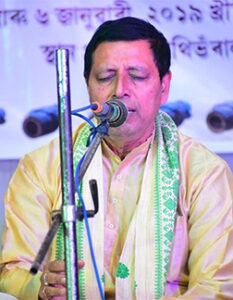
About
Shri Gunindra Nath Ojah is one of the eminent Borgeet singers of Assam, belonging to renowned Ojah family from Barpeta, Assam.
Date and place of the Interview:
29 August, 2020; Residence of Shri Ojha, Barpeta, Assam
Interview Format:
Face-to-face conversation
We belong to the Ojah family. Since the time of Mahapurukh Sankardeva the Ojah ancestry has been playing significant roles in many ways. During the time of Mathura Das Burha Ata, the first Sattradhikar of Barpeta Sattra, different tasks of the Sattra were distributed for proper management by forming different groups such as Gayan-Bayan, Ojapali, Borgeet, Ankiya Bhaona etc. Narayan Das Ata Ojah was the first person from Ojah family to lead the Borgeet group and practised Borgeets as prayer songs. Since that time this tradition and responsibility have been continuing from one generation to the next. This is how I started my journey as a Borgeet singer.
See, the words we pronounce or the tone of our language vary according to the place we belong. Even our Assamese language has so many dialects and we speak differently in different parts of Assam. The same reason is applicable for different forms of Borgeet. But if you listen carefully, all are so nice to our ears. Another reasons is that the same lyrics could be sung in different tunes for different events such as Ojapali, Dance, Music and so on.
Yes, This is true. To be an Adhikar in a Sattra, the person must have some special qualities or skills. Such creative personalities added new things in Sattriya culture later on. The famous “Geetghati Xur” of Barpeta Sattra is known as the “Bandha Raag” in upper Assam area. During the period of Gurajona, the raag were fixed for songs, but not the taal. Later the other Adhikars and ‘Ata Purux’ created and added new bols and taal by their own understanding. This is why we find differences in terms of rhythm, taal, Bol for the same song. Perosnally, I think, rather than making it a controversy, we should celebrate this diversity that for single song we have different taals, rhythm etc.
Of course! As I mentioned earlier, same lyrics could sing in different tunes for different events such as dance or Abhinoi. As an example, for the borgeet “Arye Uddaba Chalahu Gakula Laai” – the original raag is “Shreerag” and taal is “Ektaal”; but for dance purpose (in Jumura Geetor Naas) the raag used is “Amotkalyan” and the taal is “Jatitaal”. Also, the original melody of the song is “Karun” (Sad), but for dance, the melody is completely different. These are subtle differences and sometimes people are not able to spot the nuances, leading to making mistakes during presentation.
I completely agree and would love to work for this type of project. I believe young generation such as yours should come and initiate these kind of projects. But it is very important to maintain the originality before presenting anything. To perform and represent a Borgeet, one must have a good knowledge in raag, taal, rhythm, tune, and instrument used.
Although the song “Kompito Madhaba” is mentioned as Borgeet in a few books, this is actually a song from Ankiya Naat, “Arjun Bhanjan”, known as “Naator Geet”. I really appreciate the artist for this initiative. But there are some areas to concentrate, such as raag, pronunciation (try not to break one single word as much as possible), instruments etc. This will help keep the originality alive.
I am very optimistic for the final outcome of this project. We used Borgeets, Goxha-Kirtans in the movie. Everybody gave their best. Work is still going on. I hope audience will love this initiative.
Prabandha Geet from Odisha has several similarities with our Borgeet. We could think of cultural collaborations with them, but at present I do not have any such project.
With the recognition of Sattriya Dance as one of the forms of Indian Classical Dance, there is awareness of Sattriya Culture in-and-outside India. The Sattriya Music is still to get due recognition, but I am very positive on the future outlook. I believe Borgeet and other forms of Sattriya music could be a good career option for our upcoming generation. There will always be opportunities provided the students have the depth in knowledge, patience and commitment for our culture.
Government is providing some facilities for the artists engaged in Sattriya practice, but not as much as they should if we think of taking Sattriya to the world stage. It is unfortunate that many artists have to undergo financial distress even after devoting their whole life for Sattriya. This is precisely the point which contradicts my previous answer why a student should consider Sattriya dance/music/instruments as a career option. Please note, Government has limited role and all of us needs to play our roles as well.
